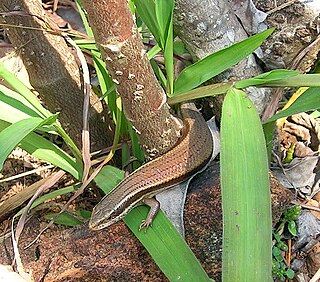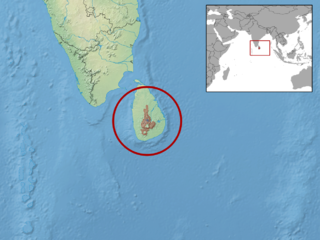
Parvoscincus is a genus of skinks, lizards in the family Scincidae. The genus is endemic to the Philippines.

Sphenomorphus dussumieri, commonly known as Dussumier's forest skink and Dussumier's litter skink, is a species of skink, a lizard in the family Scincidae. The species is endemic to southern India.

Lygosominae is the largest subfamily of skinks in the family Scincidae. The subfamily can be divided into a number of genus groups. If the rarely used taxonomic rank of infrafamily is employed, the genus groups would be designated as such, but such a move would require a formal description according to the ICZN standards.

Dasia griffini, commonly known as Griffin's keel-scaled tree skink or Griffin's dasia, is a species of tree skink, a lizard in the family Scincidae. The species is endemic to central and northern Palawan and southern Mindoro in the Philippines.

Lankascincus deignani, commonly known as Deignan's tree skink and the Deignan tree skink, is a species of lizard in the family Scincidae. The species is endemic to the island of Sri Lanka.

Otosaurus cumingii, commonly called Cuming's sphenomorphus or the Luzon giant forest skink, is a species of skink, a lizard in the family Scincidae. The species is endemic to the Philippines.

Lipinia pulchella, known commonly as the yellow-striped slender tree skink or beautiful lipinia, is a species of skink, a lizard in the family Scincidae. The species is endemic to the Philippines.
Pinoyscincus is a genus of skinks, lizards in the family Scincidae. All species in the genus are endemic to the Philippines. Species in this genus were previously assigned to the genus Sphenomorphus.

Insulasaurus arborens, also known as the Negros sphenomorphus, is a species of lizard of the family of Scincidae. It is endemic to the Philippines.
Parvoscincus beyeri, also known commonly as Beyer's sphenomorphus, is a species of skink, a lizard in the family Scincidae. The species is endemic to the Philippines.
Parvoscincus lawtoni is a species of lizard in the subfamily Sphenomorphinae of the family Scincidae (skinks). The species is endemic to the Philippines.
Parvoscincus tagapayo, the Aurora mountain skink, is a species of lizard in the family Scincidae. The species is endemic to the Philippines.

Pinoyscincus abdictus is a species of skink, a lizard in the family Scincidae. The species is endemic to the Philippines. There are two recognized subspecies.
Pinoyscincus coxi, Cox's sphenomorphus, is a species of skink, a lizard in the family Scincidae. The species is endemic to the Philippines. There are two recognized subspecies.

Pinoyscincus jagori, Jagor's sphenomorphus, is a species of skink, a lizard in the family Scincidae. The species is endemic to the Philippines. There are two recognized subspecies.

Pinoyscincus llanosi, also known commonly as the Leyte sphenomorphus, is a species of skink, a lizard in the family Scincidae. The species is endemic to the Philippines.
The Mindanao sphenomorphus is a species of skink, a lizard in the family Scincidae. The species is endemic to the Philippines.
Sphenomorphus helenae, also known commonly as the Notaburi forest skink, is a species of lizard in the subfamily Sphenomorphinae of the family Scincidae. The species is endemic to Thailand.
Sphenomorphus woodfordi is a species of skink, a lizard in the family Scincidae. The species is native to the Solomon Islands and Bougainville.
Tytthoscincus hallieri is a species of skink, a lizard in the family Scincidae. The species is native to Southeast Asia.












